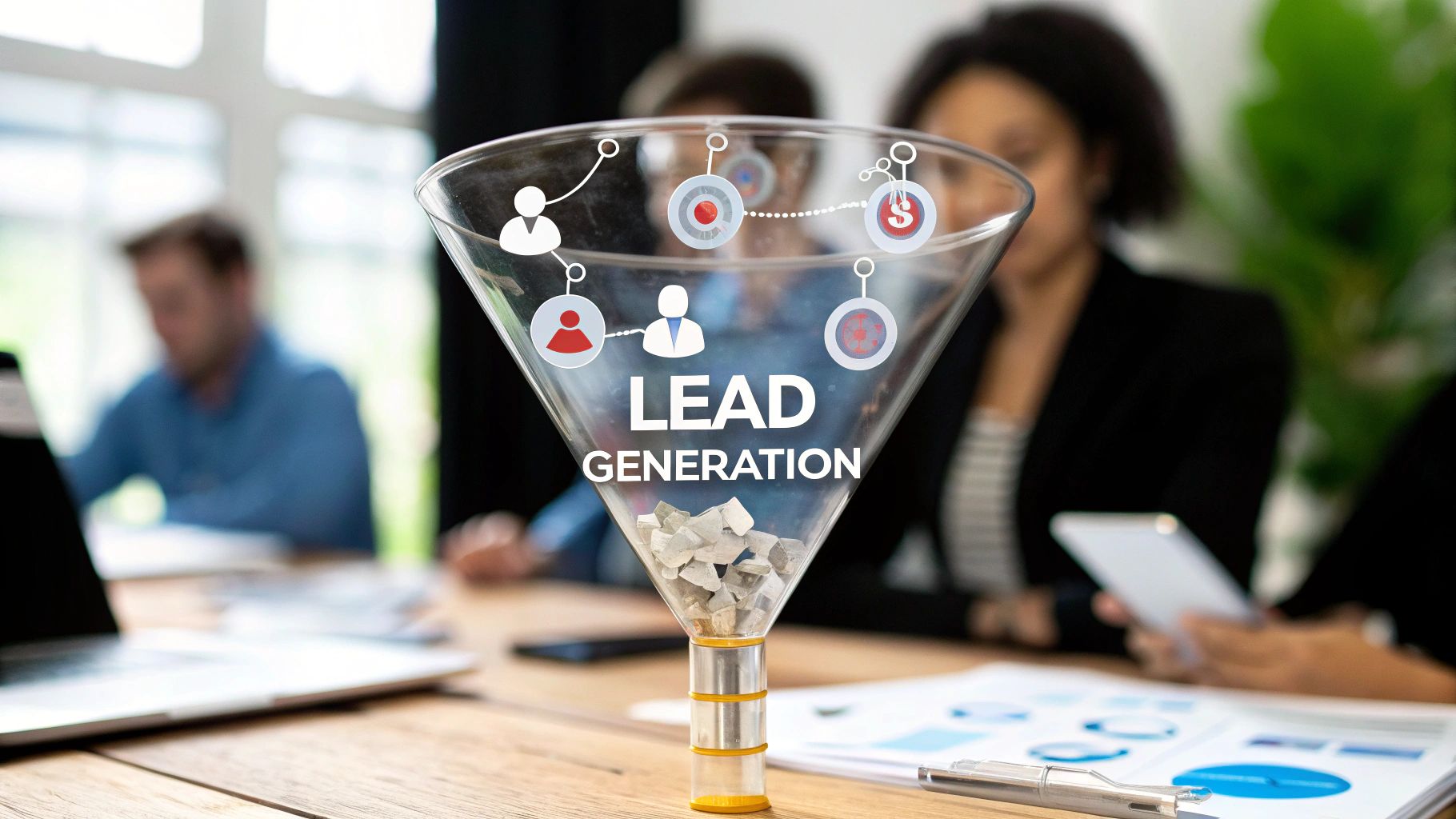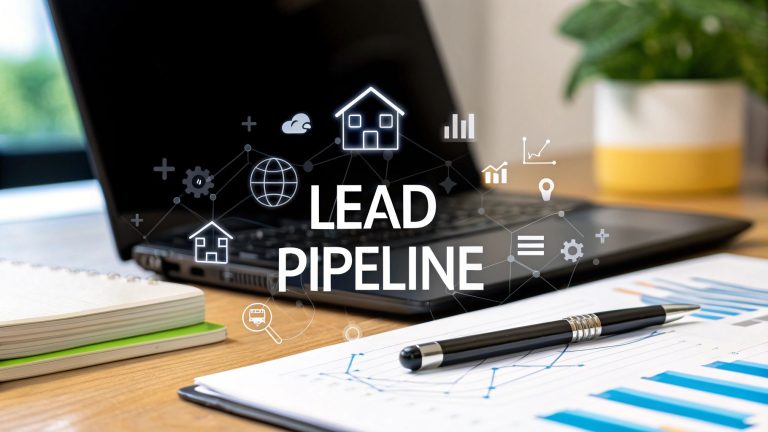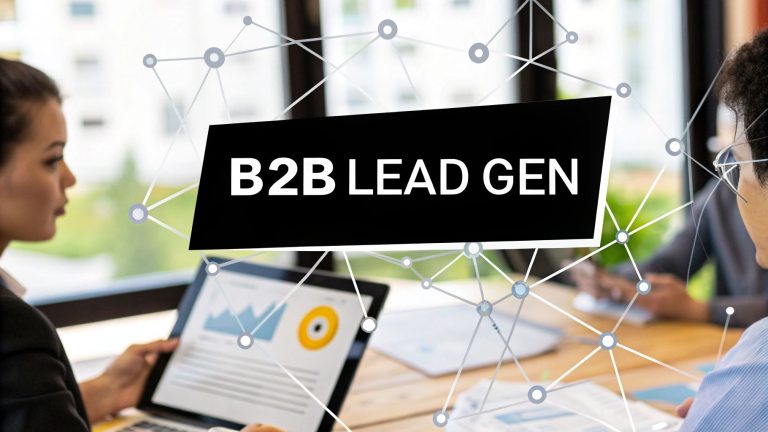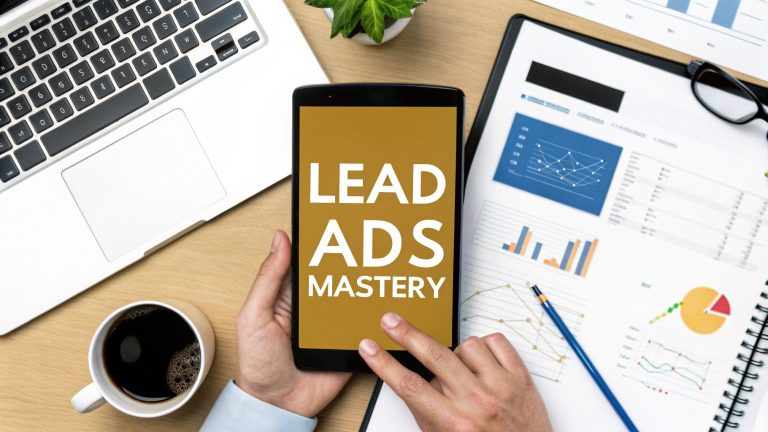What is Lead Generation in Marketing? Key Strategies Explained
In the world of marketing, lead generation is all about sparking interest in what your business does. It’s the art of attracting potential customers and getting them to raise their hand, showing they want to learn more.
This is the very first, and most crucial, step in turning a complete stranger into a curious prospect, and eventually, a happy customer. The main goal? To build a list of people who have willingly said, "Hey, I'm interested in what you have to offer."
The Foundation of Business Growth

At its heart, understanding what is lead generation in marketing is really about figuring out how to start a conversation with someone who might one day buy from you.
Think of your website like a digital storefront. Plenty of people might walk by (that's your website traffic). A lead, however, is someone who decides to step inside, look around, and gives you their contact info so you can tell them more.
This entire process is the lifeblood of any business that wants to grow sustainably. Without a steady flow of new leads, your sales pipeline will eventually run dry. It’s the engine that keeps your whole sales funnel moving, giving your team the raw materials they need to close deals.
From Anonymity to Connection
The real magic of lead generation is how it transforms an anonymous website visitor into someone you can actually talk to. Before they give you their information, you have no way of reaching the people checking out your brand.
But once they hand over something like an email address in exchange for a helpful guide or a free checklist, the whole dynamic changes.
You've earned their permission to start a conversation. This is the key difference between just having an audience and building an active list of potential customers you can nurture.
That shift from just broadcasting your message to starting a real dialogue is where true business growth kicks in. You're no longer shouting into the void; you're opening a direct line of communication.
What Constitutes a Lead?
So, what actually counts as a lead? It’s not just any random contact. It’s someone who has shown genuine interest in your company through a specific action.
This interest can show up in a few different ways:
- Downloading Content: Someone who grabs your latest ebook, whitepaper, or case study.
- Subscribing to a Newsletter: A person who signs up to get regular updates and tips from you.
- Requesting a Demo: A prospect who is interested enough to ask for a live look at your product.
- Filling Out a Contact Form: An individual reaching out with a specific question or a request for more information.
Each one of these actions is a signal. It separates a casual browser from someone who could become a customer down the road. For marketing agencies, mastering this process is non-negotiable for proving their value and getting results for clients.
If you want to get into the nitty-gritty, you can explore specialized strategies in our guide on lead generation for marketing agencies. This first interaction is the starting point for building trust and guiding them toward a sale.
Inbound vs Outbound Lead Generation Strategies
When you get down to the brass tacks of what is lead generation in marketing, you'll quickly find there are two main schools of thought for making that first contact. It's really the difference between being a magnet or a megaphone.
Do you draw people in who are already searching for what you offer? Or do you go out and broadcast your message to find them?
This is the fundamental split between inbound and outbound lead generation. Both approaches are essential, but they operate in completely different ways. Getting a handle on their unique pros and cons is the first real step to building a strategy that keeps your sales pipeline humming.
The Power of Attraction: Inbound Lead Generation
Inbound lead generation is all about earning attention instead of buying it. The whole idea is to create valuable, genuinely helpful content that pulls your ideal customers toward you, naturally.
Think of it like being a great host at a party. You don't chase guests down; you create an amazing atmosphere with great music and food (your content), and people flock to you. You become a trusted resource they actively look for, rather than an interruption in their day.
Key inbound strategies include:
- Content Marketing: Publishing blog posts, in-depth guides, and videos that actually solve the problems your target audience faces.
- Search Engine Optimization (SEO): Fine-tuning your website and content to show up at the top of Google when people are actively searching for answers you provide.
- Social Media Marketing: Building a real community on the platforms where your audience hangs out, sharing useful tips and building relationships.
The real magic of inbound? The leads who come to you are often way more engaged and ready to talk. They initiated the conversation because they have a problem and believe you're the one to solve it.
The Direct Approach: Outbound Lead Generation
Outbound lead generation flips the script—it’s about proactively seeking attention. This strategy involves reaching out directly to potential customers you've identified as a good fit, even if they haven't heard of you before. This is the "megaphone" approach, where you broadcast a targeted message to a specific audience.
And while some might think of it as old-school, modern outbound is incredibly smart and data-driven. We're not talking about randomly dialing phone numbers anymore; it's all about strategic, personalized outreach.
Outbound marketing is about finding the right people and starting the conversation yourself. It’s a direct and often faster way to generate initial interest, especially for new businesses or those entering new markets.
Common outbound methods include:
- Targeted Digital Ads: Using platforms like Google Ads or social media ads to put your message right in front of specific demographics and interests.
- Strategic Email Outreach: Sending highly personalized emails to a carefully curated list of prospects who match your ideal customer profile.
- Industry Events: Getting face-to-face at trade shows and conferences to network and connect with potential clients.
Outbound can get you results fast and is easy to scale up with a bigger budget. The catch is that it can be more expensive and might feel a bit intrusive if your execution isn't sharp.
Inbound vs Outbound Lead Generation Comparison
So, which one is better? Honestly, neither. They just do different jobs, and the smartest companies use a mix of both to build a powerful lead-generation machine. Inbound builds a long-term asset, while outbound can give you a quick, targeted boost right when you need it.
Here’s a quick table to show you how they stack up at a glance.
| Attribute | Inbound Marketing (Earning Attention) | Outbound Marketing (Seeking Attention) |
|---|---|---|
| Approach | Pulls customers in with valuable content and resources. | Pushes messages out to a targeted audience. |
| Lead Quality | Generally higher, as leads are self-qualified and actively seeking solutions. | Can vary; leads may not be actively looking for a solution at that moment. |
| Cost | Often lower long-term cost, but requires upfront investment in content creation. | Can have a higher per-lead cost, especially with paid advertising. |
| Scalability | Can be slower to scale initially but builds compounding, long-term value. | Highly scalable and can generate results quickly with increased budget. |
| Primary Methods | SEO, blogging, social media content, webinars, ebooks. | Digital ads, email outreach, event sponsorships, direct mail. |
Ultimately, a balanced approach almost always wins. Using inbound strategies creates a sustainable foundation of trust and authority, while outbound provides the firepower to hit specific targets and accelerate growth.
The Four Stages of a Modern Lead Generation Funnel
Thinking about lead generation as a single action is a mistake. It’s not just one thing; it’s a journey you guide potential customers on. The best way to visualize this is as a funnel—a deliberate process designed to turn strangers into your biggest fans.
If you're asking yourself, "what is lead generation in marketing?", understanding this funnel is the key.
This modern funnel breaks down into four distinct stages: Attract, Convert, Close, and Delight. Each step has its own goal and requires a different set of plays to get right. By mapping it out this way, you can build a smooth customer experience that fuels real, sustainable growth.
The infographic below shows how different marketing efforts, like inbound and outbound, all feed into this process.
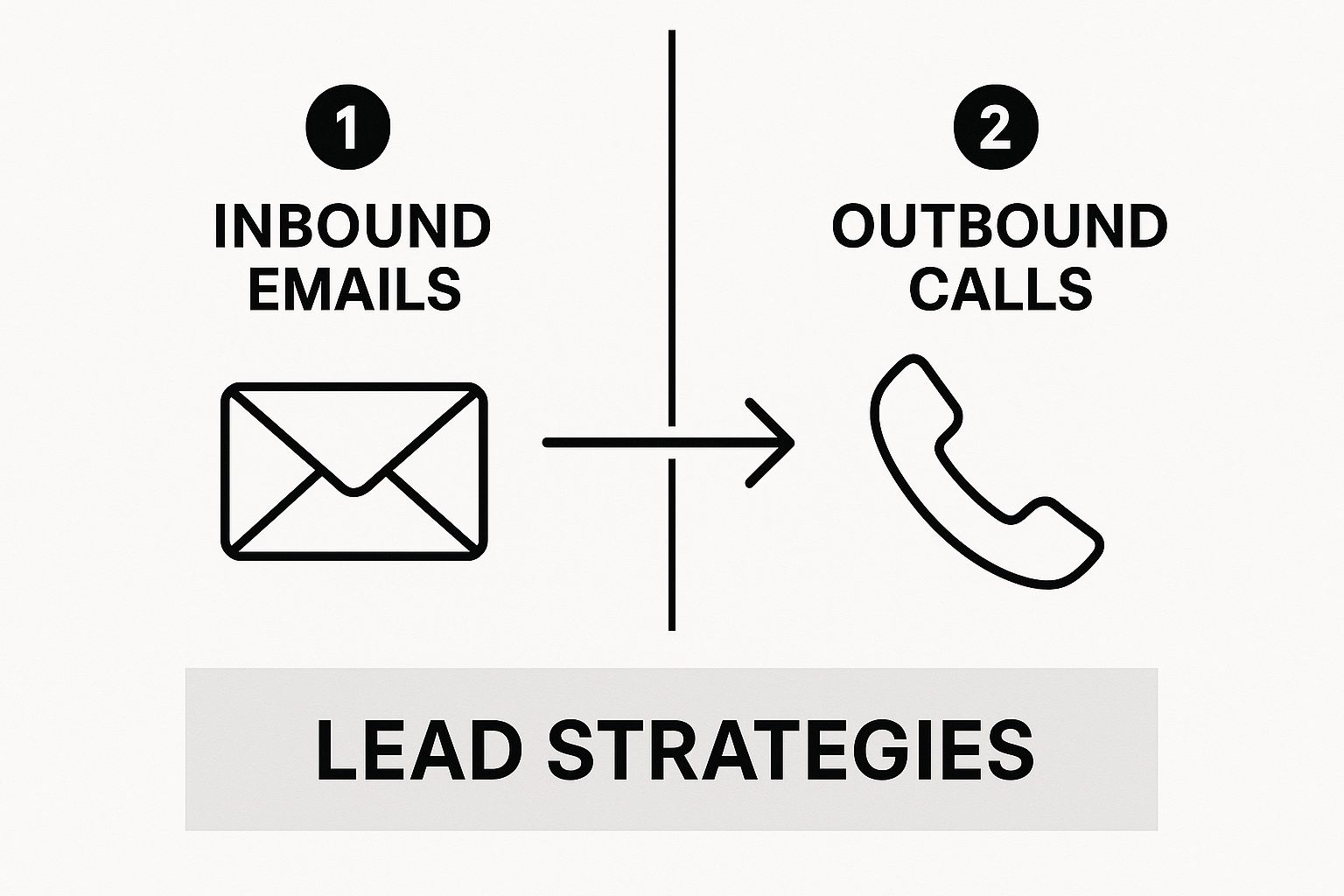
As you can see, you need both "pull" tactics (inbound) and "push" tactics (outbound) to keep your funnel full and kickstart the customer journey.
Stage 1: Attract Strangers into Visitors
The first stage is all about getting noticed. Your goal isn't just to get any traffic to your website or blog; it's to attract the right people—the ones who are actually a good fit for what you sell.
This is where inbound marketing really comes alive. You create helpful, relevant content that speaks directly to the problems and questions of your ideal customer.
- Search Engine Optimization (SEO): Getting your website to show up on Google when your ideal customer is searching for solutions.
- Content Marketing: Publishing useful blog posts, creating how-to videos, and sharing valuable updates on social media to pull people in.
- Targeted Advertising: Running smart ads on search engines or social media to get in front of specific groups of people.
The mission here is simple: become a trusted resource. Turn anonymous strangers into engaged visitors who see you as an authority in your space.
Stage 2: Convert Visitors into Leads
Okay, so you’ve got people on your site. Now what? The next crucial move is to turn them into actual leads. This is the moment of truth—the exchange where a visitor gives you their contact information, essentially raising their hand and saying, "I'm interested. Let's talk more."
This almost always happens on a landing page, a webpage built for one single purpose: capturing that lead's info. To convince someone to give you their email, you need to offer something valuable in return. We call this a lead magnet.
A lead magnet is basically an ethical bribe. It's a specific piece of high-value content you offer a prospect in exchange for their contact details. The better the bribe, the higher your conversion rate.
Great lead magnets include things like:
- In-depth ebooks or guides
- Handy templates or checklists
- A spot in an exclusive webinar
- A free trial or product demo
The visitor gets this awesome resource by filling out a form, which they click on after seeing a clear call-to-action (CTA) like "Download Your Free Checklist Now!"
Stage 3: Close Leads into Customers
Getting a lead is a huge win, but the work is far from over. Most people who download your ebook aren't ready to pull out their credit card right away. The "Close" stage is all about nurturing the relationship you just started and gently guiding your leads toward a sale.
This is where your marketing and sales efforts join forces. Using a Customer Relationship Management (CRM) system, you can track every interaction and send personalized, timely follow-ups. Email marketing is your best friend here, as it lets you build trust one message at a time.
A good lead nurturing sequence might look like a series of emails that offer more helpful tips, answer common questions, and show exactly how your solution solves their problem. This process warms up the lead so that when a salesperson finally reaches out, the conversation is natural and effective.
Stage 4: Delight Customers into Advocates
The funnel doesn't stop once you make a sale. In fact, the most successful companies know this is where the real magic happens. The final stage, "Delight," is all about turning your new customers into raving fans who promote your brand for you.
You can create these advocates by providing an exceptional post-purchase experience.
- Amazing Customer Service: Be fast, friendly, and genuinely helpful.
- A Solid Onboarding Process: Make sure new customers know how to get the most value from their purchase.
- Exclusive Content & Perks: Reward loyal customers with special access or information.
Delighted customers don't just come back for more; they become your most powerful marketing asset. They leave glowing reviews, tell their friends about you, and provide the social proof that feeds new, high-quality prospects right back into the top of your funnel. It's a self-perpetuating cycle of growth.
Powerful Channels for Generating High-Quality Leads
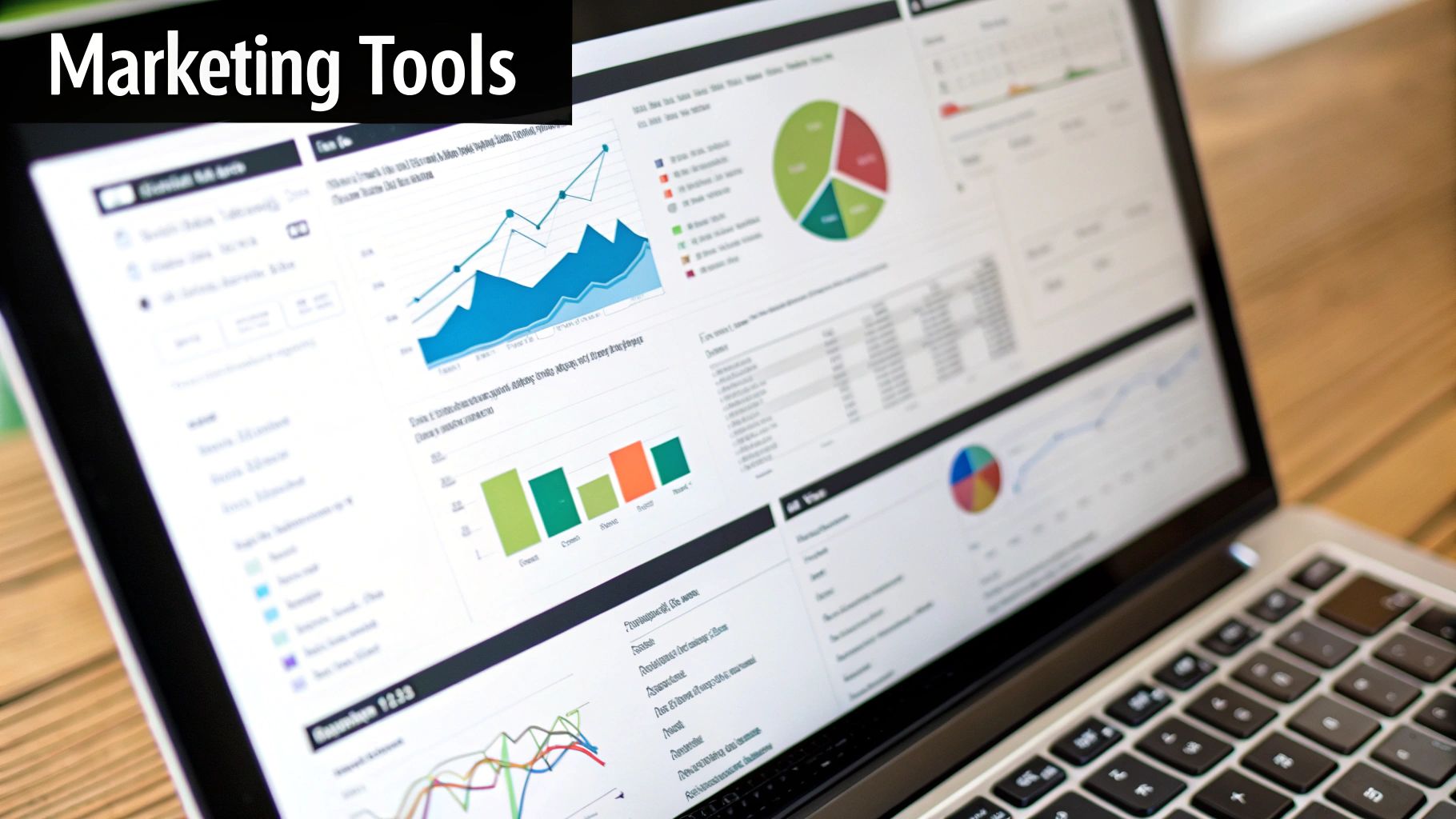
So, you get the 'what' and 'why' of the lead generation funnel. Great. But the real question is how. How do you actually get this whole thing moving?
Moving from theory to practice means picking the right channels to find, engage, and convert the people you want to reach. Think of these channels as different highways, all leading potential customers straight to your business.
A solid strategy rarely bets on just one horse. Instead, it’s about mixing and matching several channels to create a steady stream of good prospects. Let's dig into some of the most powerful and popular options out there.
Content Marketing as a Lead Magnet
Content marketing is the absolute engine behind most successful inbound strategies. It's not about a hard sell. It’s about being genuinely helpful by offering valuable, relevant, and free information that solves your audience's problems. Do this consistently, and you build incredible trust and position your brand as the go-to expert.
Once someone sees you as a reliable source of knowledge, they're far more willing to trade their contact info for something even more valuable. This is the heart of lead generation—it's a value exchange.
Here are a few content workhorses that pull in leads:
- In-depth Guides and Ebooks: These are meaty resources that tackle a major pain point head-on, offering a comprehensive solution.
- Webinars and Virtual Events: Live or on-demand video lets you connect directly with prospects, answer their questions on the spot, and show off your expertise.
- Case Studies and Success Stories: Nothing beats real-world proof. These show exactly how you've helped others succeed, making your promises feel real and achievable.
One of the most powerful ways to get this content discovered is through search engines. To really grasp how this works, it's worth understanding the importance of SEO in your overall marketing plan.
Email Marketing for Nurturing Relationships
Even with all the new channels popping up, email marketing remains one of the most direct and effective ways to both generate and nurture leads. It’s a personal line of communication to an audience that has already raised their hand and said, "Yes, I want to hear from you."
You can use email to build a loyal following by sending out useful tips, industry news, or exclusive deals. From there, automated "nurture sequences" can take over, sending a series of targeted messages that educate new leads and gently guide them toward making a purchase.
Email isn't just another channel; it's a powerhouse for turning interest into action. Its incredible return on investment is why it remains a core part of almost every smart marketing strategy.
The numbers back this up. Around 78% of businesses lean on email marketing to bring in leads. And the ROI? It’s staggering, averaging about $36 for every $1 spent. Welcome emails are especially potent, with engagement rates hitting nearly 64%—proving just how crucial a strong first impression is.
Social Media Marketing for Targeted Engagement
Social media platforms are where your customers hang out. They're bustling digital communities where you can connect with people in a more informal, conversational way. The trick is to show up on the platforms where your audience actually spends their time and share content that feels native to that space.
For B2B businesses, LinkedIn is a goldmine. You can share insightful articles, jump into industry discussions, and use hyper-targeted ads to reach decision-makers with specific job titles or at certain companies.
If you’re a B2C brand, platforms like Instagram and Facebook are your playground. They offer powerful visual storytelling tools and ad-targeting features that let you connect with consumers based on their interests, behaviors, and life events.
Pay-Per-Click Advertising for High-Intent Prospects
While content and social media are about building momentum over the long haul, Pay-Per-Click (PPC) advertising gives you instant visibility. It puts your brand right in front of people who are actively looking for a solution right now.
These are often high-intent prospects who are much further along in their buying journey, making them incredibly valuable leads.
For instance, someone Googling "best CRM software for small business" isn't just browsing—they're evaluating options and are likely close to making a decision. By running a targeted PPC ad for that exact search term, you can catch their attention at the perfect moment and send them to a landing page built to convert.
Measuring the Metrics That Actually Matter
Getting a rush of new leads feels great, but it’s only half the story. If you aren't tracking your efforts, you’re flying blind. You might be busy, but are you actually being effective? To truly understand lead generation, you have to look at the numbers that tell you what’s working and what’s a waste of money.
It’s tempting to get excited about vanity metrics like social media likes or impressions. But those numbers don't pay the bills. Real success comes from tracking the metrics that draw a straight line from your marketing spend to your bank account.
Core Metrics for Your Dashboard
To get a clear picture of your lead generation health, you really only need to start with a few key performance indicators (KPIs). Think of these as the vital signs for your marketing engine.
- Cost Per Lead (CPL): This is straightforward: how much are you paying for every single lead you generate? It’s the first and most basic measure of how efficient your campaigns are.
- Formula: Total Marketing Spend / Total New Leads = CPL
- Lead-to-Customer Conversion Rate: This percentage shows how good you are at turning curious prospects into actual paying customers. A low rate here could mean your sales process is leaky or your leads aren't a good fit.
- Formula: (New Customers / Total Leads) * 100 = Lead-to-Customer Rate
- Customer Acquisition Cost (CAC): This is the big one—the total cost to land one new customer, factoring in all your marketing and sales expenses. It's the ultimate report card for how much it costs to grow.
- Formula: (Total Marketing + Sales Costs) / New Customers = CAC
Keeping an eye on these numbers helps you make smarter decisions with your budget and fine-tune your strategies for real growth, not just clicks and likes. For a deeper dive into what to track, check out our guide on how to measure marketing effectiveness.
Understanding What the Numbers Tell You
Each metric tells a part of the story. A high CPL might mean your ad targeting is too broad. A low lead-to-customer rate could be a signal that your sales team is getting junk leads. The goal isn’t just to get low numbers; it’s to find a profitable balance.
For example, a super low CPL is awesome, but not if those "cheap" leads never buy anything. On the flip side, a high CAC isn’t always a red flag, especially if the lifetime value of those customers is massive. It’s all about context.
The most important relationship is between what you spend and what you earn. A healthy lead generation machine is one where the cost to acquire a customer (CAC) is significantly lower than the value that customer brings in over time.
To really dial in your profitability, you need to understand every piece of this puzzle. You can learn more about how to lower your Cost Per Acquisition (CPA) to make sure you’re getting the best possible return.
By regularly checking these metrics, you can stop guessing and start making decisions based on cold, hard data. This is how you prove your marketing is working and build a pipeline that fuels sustainable growth.
Why Lead Nurturing Is Your Secret Weapon
Capturing a new lead is a great start, but it's rarely the end of the story. Think about it—most people, especially in the B2B world, aren't ready to pull out their credit card the second they download a guide. This is where lead nurturing becomes your most powerful tool. It’s the art of building a real relationship over time.
Consider it the essential bridge connecting your marketing team's initial win to your sales team's closed deal. Lead nurturing is all about guiding prospects through their decision-making journey, not by pushing them, but by providing consistently helpful content that builds trust and cements you as the go-to expert.
Guiding Prospects from Interest to Action
Great lead nurturing is about delivering the right message at exactly the right time. Instead of rushing to a sales pitch, you focus on educating and helping your leads solve their problems. This strategic patience creates smarter, more qualified prospects who feel confident in their decision to choose you.
This is where marketing automation is no longer a "nice-to-have" but a must-have. Automated systems can send personalized content based on a lead's specific actions, making every touchpoint feel relevant and valuable. For a deep dive into how this works, check out our guide on automated lead nurturing.
Lead generation isn't just about getting names in a list; it's about cultivation. The goal is to turn that initial spark of curiosity into genuine trust, making the final sale feel like a natural, logical next step.
This careful process has a massive impact on your bottom line. Research shows that B2B companies with mature lead nurturing and generation processes bring in 133% more revenue on average. A huge driver of this is marketing automation, which has been shown to boost qualified leads by an incredible 451%. This data makes it clear: a smart, nurturing-focused strategy leads to real, profitable growth. You can see more on these lead capture findings.
The Tangible Benefits of Nurturing
A well-oiled lead nurturing machine doesn't just create happy prospects; it delivers measurable results that strengthen your entire sales pipeline.
Here are the key benefits you can expect:
- More Sales-Ready Leads: Nurtured leads have a much better grasp of your solution and their own needs, so they're far more prepared for a productive sales call.
- Shorter Sales Cycles: When leads are already warmed up and informed, the path from conversation to contract gets a whole lot shorter and smoother.
- Increased Customer Lifetime Value: The trust you build before the sale even happens often translates into stronger, more loyal customer relationships for years to come.
Frequently Asked Questions About Lead Generation
Even after you get the hang of the basics, some practical questions always seem to pop up. Let's tackle some of the most common ones I hear from marketers to clear up any confusion and make sure you understand how lead generation really works in practice.
What Is the Difference Between a Lead and a Prospect?
This one trips people up all the time. While many use "lead" and "prospect" interchangeably, they're actually two different stops on the customer journey.
A lead is simply someone who has shown a flicker of interest. They gave you their contact info, maybe for a webinar or an ebook. They've raised their hand, but you have no idea if they're a good fit for what you sell.
A prospect, on the other hand, is a lead you've actually vetted. You've done your homework and confirmed they match your ideal customer profile. They have the budget, the authority to buy, and a real need for your solution. They're a genuinely viable potential customer.
Think of it like fishing. You cast a wide net and catch a bunch of fish (leads). The ones that are the right size and species—the keepers—are your prospects.
In short, every prospect starts out as a lead, but only a fraction of your leads will ever become prospects.
How Do You Determine if a Lead Is High-Quality?
Figuring out which leads are high-quality is the secret to not wasting your sales team's time. A great lead isn't just someone who grabbed a freebie; they're someone who shows clear signs they intend to buy and actually fits your target customer demographic.
Here are a few solid ways to gauge lead quality:
- Lead Scoring: This is a system where you assign points to leads for their actions (like visiting your pricing page) and their attributes (like their job title or company size). Higher scores mean hotter leads.
- The BANT Framework: A classic for a reason. You evaluate a lead based on their Budget, Authority to buy, Need for what you offer, and their Timeline for making a purchase.
- Engagement Level: Pay attention to how often a lead interacts with your emails, website, or content. Someone who keeps coming back is almost always more interested than someone who visited once and disappeared.
How Long Does Lead Generation Take?
This is the million-dollar question, and the honest answer is: it depends entirely on your strategy and industry.
If you go the outbound route with something like PPC ads, you can start seeing leads almost immediately—sometimes within just a few hours of launching a campaign.
But inbound strategies like content marketing and SEO are a different beast. They're the long game. It can easily take 3-6 months to build up enough authority and organic search rankings to see a consistent flow of leads. The upside? These leads are often much higher quality and more cost-effective over the long haul.
The smartest approach is usually a mix of both—use short-term tactics for quick wins while you build your long-term, sustainable lead generation engine.
Ready to stop manually downloading Facebook leads and start converting them faster? LeadSavvy Pro automates the entire process, sending new leads directly to your Google Sheet or CRM the moment they come in. Try our free plan and see the difference. Get started with LeadSavvy Pro today

